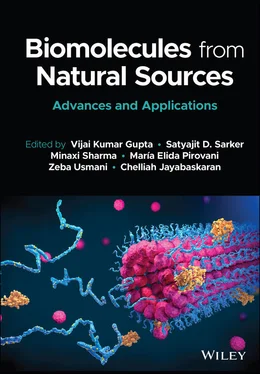Biomolecules from Natural Sources
Здесь есть возможность читать онлайн «Biomolecules from Natural Sources» — ознакомительный отрывок электронной книги совершенно бесплатно, а после прочтения отрывка купить полную версию. В некоторых случаях можно слушать аудио, скачать через торрент в формате fb2 и присутствует краткое содержание. Жанр: unrecognised, на английском языке. Описание произведения, (предисловие) а так же отзывы посетителей доступны на портале библиотеки ЛибКат.
- Название:Biomolecules from Natural Sources
- Автор:
- Жанр:
- Год:неизвестен
- ISBN:нет данных
- Рейтинг книги:5 / 5. Голосов: 1
-
Избранное:Добавить в избранное
- Отзывы:
-
Ваша оценка:
- 100
- 1
- 2
- 3
- 4
- 5
Biomolecules from Natural Sources: краткое содержание, описание и аннотация
Предлагаем к чтению аннотацию, описание, краткое содержание или предисловие (зависит от того, что написал сам автор книги «Biomolecules from Natural Sources»). Если вы не нашли необходимую информацию о книге — напишите в комментариях, мы постараемся отыскать её.
An up-to-date exploration of new and novel biomolecules Biomolecules from Natural Sources: Advances and Applications,
Biomolecules from Natural Sources: Advances and Applications
Natural Sources: Advances and Applications
Biomolecules from Natural Sources — читать онлайн ознакомительный отрывок
Ниже представлен текст книги, разбитый по страницам. Система сохранения места последней прочитанной страницы, позволяет с удобством читать онлайн бесплатно книгу «Biomolecules from Natural Sources», без необходимости каждый раз заново искать на чём Вы остановились. Поставьте закладку, и сможете в любой момент перейти на страницу, на которой закончили чтение.
Интервал:
Закладка:
Kuyukina et al. (2016) described the production of trehalose lipid from Rhodococcus ruber IEGM 231 using 3% (v/v) n -hexadecane at 160 rpm, 28°C for 48 h, and the antiadhesive and biofilm-preventing effects against Gram-positive and Gram-negative bacteria strains. Additionally, interesting anti-adhesive effects were obtained using the trehalose lipid at 10 mg L -1against actively growing B. subtilis ATCC 6613, Corynebacterium glutamicum IEGM 1861, E. coli K-12, Micrococcus luteus IEGM 401, and Pseudomonas fluorescence NCIMB 9046 cells with different percentages of inhibition (30–76%) (Kuyukina et al. 2016). Moreover, these authors suggested that anti-adhesive properties were dependent on hydrophobicity/surface characteristics of the strains tested and their physiological stage and not strongly dependent upon the concentration of trehalose lipid (Kuyukina et al. 2016).
A trehalose lipid biosurfactant secreted by Rhodococcus fascians BD8 was investigated as an anti-microbial and anti-adhesive against pathogenic bacteria and Candida albicans to polystyrene, silicone, and glass surfaces (Janek et al. 2018). Up to 95% prevention of Candida albicans adhesion to a polystyrene surface was achieved with 0.5 mg mL -1trehalose lipid. The authors (Janek et al. 2018) concluded that the exploration of trehalose lipid interaction with medical surfaces using quantum chemical calculations and due to its surface tension properties, trehalose lipids are interesting as surface coating agent against microbial colonization of various surfaces (e.g., implants and urethral catheters).
1.10 Conclusions
Glycolipid biosurfactants are surface-active natural compounds produced by several microorganisms with biological activities and potential applications in environmental, medical, cosmetic, pharmaceutical, and food industries.
Microbial glycolipid biosurfactants have many advantages over chemically synthesized surfactants, such as lower toxicity, they are environmentally friendly, have similar surface activity. Downstream processing is probably the most expensive process in the production of microbial glycolipids. To obtain pure glycolipids from production medium requires several operations and purification steps, with extraction being still the most commonly used.
The use of economically feasible renewable substrates, the optimization of growth and production conditions and efficient multi-step downstream processing will enhance the manufacturing and application of glycolipids, and be more profitable.
Novel recombinant varieties, especially beyond the development of novel recombinant microorganism hyperproducers may potentially bring the required development in these biosurfactant production process.
With ever increasing reports regarding the therapeutic and biomedical properties of glycolipids (e.g. trehalose lipids) as biosurfactants, these molecules will surpass the realm of surfactants and might emerge as highly valued molecules with relevance to health in the near future. The future application of glycolipids (e.g. trehalose lipids) in drugs or medicines will make it really interesting for industry. Therefore, future glycolipid research should be focused on making the production process economical with the potential use of hyperproducers in addition to novel cost-effective bioprocesses.
In the study of trehalose lipids, future work should be focussed on the use of inexpensive (when adequate) carbon substrates, optimization of C/N and enviromental conditions, leading to the highest yields, combined with cost effective downstream processing methods. A large group of biosurfactant producers belonging to the generas Rhodococus , Gordonia or Torulopsis have not been exploited extensively for the economical production of trealose lipids.
Additionally there is the possibility of further chemical modifications of trehalose lipids, to obtain novel analogues with diverse and improved properties.
References
1 Abdel-Mawgoud, A.M. and Stephanopoulos, G. (2018). Simple glycolipids of microbes: chemistry, biological activity and metabolic engineering. Synthetic and Systems Biotechnology 3 (1): 3–19.
2 Almeida, D.G., Soares Da Silva, R.C.F., Luna, J.M., Rufino, R.D., Santos, V.A., Banat, I.M., and Sarubbo, L.A. (2016). Biosurfactants: promising molecules for petroleum biotechnology advances. Frontiers in Microbiology 7: 1–14.
3 Anderson, R.J. and Newman, M.S. (1933). The chemistry of the lipids of tubercle bacilli: XXXIII. Isolation of trehalose from the acetone-soluble fat of the human tubercle bacillus. The Journal of Biological Chemistry 101: 499–504.
4 Aparna, A., Srinikethan, G., and Hedge, S. (2011). Effect of addition of biosurfactant produced by Pseudomonas ssp. on biodegradation of crude oil. International Proceedings of Chemical, Biological & Environmental Engineering 6: 71.
5 Ashby, R.D., Solaiman, D.K.Y., and Foglia, T.A. (2008). Property control of sophorolipids: influence of fatty acid substrate and blending. Biotechnology Letters 30 (6): 1093–1100.
6 Azuma, M., Suzutani, T., Sazaki, K., Yoshida, I., Sakuma, T., and Yoshida, T. (1987). Role of interferon in the augmented resistance of trehalose 6,6’-dimycolate-treated mice to influenza virus infection. The Journal of General Virology 68: 835–843.
7 Bachmann, R.T., Johnson, A.C., and Edyvean, R.G.J. (2014). Biotechnology in the petroleum industry: an overview. International Biodeterioration and Biodegradation 86: 225–237.
8 Baeva, T.A., Gein, S.V., Kuyukina, M.S., Ivshina, I.B., Kochina, O.A., and Chereshnev, V.A. (2014). Effect of glycolipid Rhodococcus biosurfactant on secretory activity of neutrophils in vitro. Bulletin of Experimental Biology and Medicine 157 (2): 238–242.
9 Bajaj, A., Mayliraj, S., Mudiam, M.K.R., Patel, D.K., and Manickam, N. (2014). Isolation and functional analysis of a glycolipid producing Rhodococcus sp. strain IITR03 with potential for degradation of 1, 1,1-trichloro-2,2-bis(4-chlorophenyl)ethane (DDT). Bioresource Technology 167: 398–406.
10 Banat, I.M., Franzetti, A., Gandolfi, I., Bestetti, G., Martinotti, M.G., Fracchia, L., Smyth, T.J., and Marchant, R. (2010). Microbial biosurfactants production, applications and future potential. Applied Microbiology and Biotechnology 87 (2): 427–444.
11 Bogaert, I.N.A.V., Saerens, K., Muynck, C., Develter, D.M., Soetaert, W., and Vandamme, E.J. (2007). Microbial production and application of sophorolipids. Applied Microbiology and Biotechnology 76 (1): 23–34.
12 Borsanyiova, M., Patil, A., Mukherji, R., Prabhune, A., and Bopegamage, S. (2016). Biological activity of sophorolipids and their possible use as antiviral agents. Folia Microbiologica (Praha). 61 (1): 85–89.
13 Bouassida, M., Ghazala, I., Ellouze-Chaabouni, S., and Ghribi, D. (2018). Improved biosurfactant production by Bacillus subtilis SPB1 mutant obtained by random mutagenesis and its application in enhanced oil recovery in a sand system. Journal of Microbiology and Biotechnology 28 (1): 95–104.
14 Brandenburg, K. and Seydel, U. (1988). Infrared spectroscopy of glycolipids. Chemistry Physical Lipids 96 (1–2): 23–40.
15 Bryant, F.O. (1990). Improved method for the isolation of biosurfactant glycolipids from Rhodococcus sp. strain H13A. Applied Environmental Microbiology 56: 1494–1496.
16 Bungaruang, L., Gutmann, A., and Nidetzky, B. (2013). Leloir glycosyltransferases and natural product glycosylation: biocatalytic synthesis of the C-glucoside nothofagin, a major antioxidant of redbush herbal tea. Advanced Synthesis & Catalysis 355 (14–15): 2757–2763.
17 Cameotra, S.S. and Makkar, R.S. (1998). Synthesis of biosurfactants in extreme conditions. Applied Microbiology and Biotechnology 50 (5): 520–529.
Читать дальшеИнтервал:
Закладка:
Похожие книги на «Biomolecules from Natural Sources»
Представляем Вашему вниманию похожие книги на «Biomolecules from Natural Sources» списком для выбора. Мы отобрали схожую по названию и смыслу литературу в надежде предоставить читателям больше вариантов отыскать новые, интересные, ещё непрочитанные произведения.
Обсуждение, отзывы о книге «Biomolecules from Natural Sources» и просто собственные мнения читателей. Оставьте ваши комментарии, напишите, что Вы думаете о произведении, его смысле или главных героях. Укажите что конкретно понравилось, а что нет, и почему Вы так считаете.


![Джеймс Купер - Пионеры, или У истоков Саскуиханны [The Pioneers, or The sources of the Susquehannah]](/books/395797/dzhejms-kuper-pionery-ili-u-istokov-saskuihanny-t-thumb.webp)









